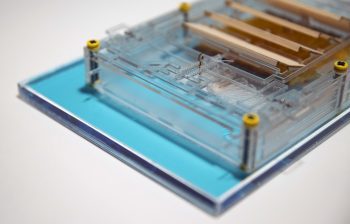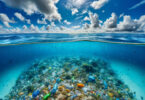November 28th, 2017
Contributing writer for Wake Up World
A new, eco-friendly technology could produce a large chunk of our energy needs, all through specially designed evaporation engines.
Using the motion of specific bacterial spores that expand and contract as they absorb and release air moisture, evaporation engines could theoretically generate 325 gigawatts of electricity (about 69% of the nation’s annual electrical generation) — which would effectively outpace coal. The process would also save around 25 trillion gallons of water every year, one fifth of the water consumption in the US. But could this technology be used without significantly affecting the environment or recreational activities on fresh water lakes?
According to Ozgur Sahin, senior coauthor of the study published in the journal Nature Communications, the answer is a solid yes.
Harnessing Natural Evaporation for Clean Energy
Anywhere there is liquid water, you’ll find the flow of vapor into the atmosphere. By harnessing the flow, we can tap into an incredible source of energy. One of the main benefits of this kind of energy is that it could be harvested on-demand, without the need for batteries — unlike with wind and solar power. Since batteries contain toxic materials and are expensive to manufacture, power from natural evaporation is a big step in the renewable energy sphere.
“We have the technology to harness energy from wind, water and the sun, but evaporation is just as powerful,” says Ozgur Sahin, a biophysicist at Columbia. “We can now put a number on its potential.”
The technology could also save a significant amount of water. Considering that about half the amount of water in lakes and reservoirs is lost through the process of natural evaporation, the research team estimates we can reduce this loss by 25 trillion gallons a year with their energy-harvesting process.
Drought-prone regions — like California, Nevada and Arizona — will have the most substantial gains with the technology, largely due to their growing populations and sunnier weather, since evaporation is strongest in warm and dry conditions.
How does it work?
A press-release from Columbia University explains:
“Evaporation is nature’s way of cycling water between land and air. Sahin has previously shown how this basic process can be exploited to do work. One machine developed in his lab, the so-called Evaporation Engine, controls humidity with a shutter that opens and closes, prompting bacterial spores to expand and contract. The spores’ contractions are transferred to a generator that makes electricity. The current study was designed to test how much power this process could theoretically produce.”
When the device is placed above water, the spores absorb moisture from evaporation and expand, which in turn opens a shutter that allows moisture to escape. Then, the spores dry out and contract, where the shutters close and allow for moisture to flow in and the entire process begins again. The device is connected to a generator that produces a small amount of power from the continuous oscillating motion.
The researchers created a simplified model to test the potential of evaporation. Since weather station data is easy to come by, they limited their calculations to the United States and excluded areas such as the Great Lakes, coastlines, farmland and rivers.
As exciting as this kind of technology is, we need to keep in mind that to produce 325 gigawatts of energy, it would require we cover every surface of every lake and reservoir larger than 0.1 square kilometers in the lower 48 states, excluding the Great Lakes, with arrays of the devices, notes Xi Chen in the MIT Technology Review.
Needless to say, this vast of a scale would be problematic for the environment as well as water recreational sports, not to mention it could even alter local weather if the device spread across a large enough lake.
However, Sahin says the study is meant to demonstrate the potential for such technology, where it would make a major contribution to clean energy when used in remote reservoirs already generating hydroelectric power. He points out it could offer the added benefit of reducing water loss through evaporation, increasing the amount available for energy generation, irrigation, and other needs.
Funding for the study was through the U.S. Department of Energy, David and Lucile Packard Foundation, National Science Foundation and Wyss Institute for Biologically Inspired Engineering.
Article sources:
- www.news.columbia.edu/content/1736
- www.nature.com/articles/s41467-017-00581-w
- www.climatenewsnetwork.net/23159-2
- www.technologyreview.com/…/evaporation-engines-could-produce-more-power-than-coal-with-a-huge-caveat
- www.nature.com/articles/ncomms8346
Recommended articles by Carolanne Wright:
- Want Cancer? Eat Plenty of Refined Sugar, Say Researchers
- A Glorious Fight Against Food Waste: Supermarket Chain Celebrates “Ugly” Produce — With Stunning Results
- Iceland Taught Kids How to Get Naturally High – And Teenage Substance Abuse Plummeted
- Brain Scans Show Psychedelic Drugs Really Do Spark Heightened States of Consciousness
- A Tiny House Revolution: Sell Your Crap, Free Your Finances and Live the Good Life for Less
- Brain Waves and Binaural Beats: A Gateway to Higher Consciousness, Enhanced Learning and Brain Function
- States With Medical Marijuana Laws Have Lower Rates of Opioid-Related Deaths, Study Finds
- 85% of Tampons, Pads and Other Feminine Care Products Contaminated with Monsanto’s Cancer-Causing Glyphosate
- Why Every Parent Should Consider Unschooling
- Plastic-Eating Mushroom Discovered in the Amazon Rainforest — A Solution for Our Trash Saturated World?
- The Astonishing Success of Fleet Farming: Breaking New Ground in the “Food Not Lawns” Movement
- Miraculous Healing Using the Power of the Mind is Possible – Here’s Why
About the author:
I’m Carolanne — a writer, chef, traveler and enthusiastic advocate for sustainability, organics and joyful living. It’s good to have you here. If you would like to learn more, connect with me at Thrive-Living.net or visit Twitter.com/Thrive_Living.
If you've ever found value in our articles, we'd greatly appreciate your support by purchasing Mindful Meditation Techniques for Kids - A Practical Guide for Adults to Empower Kids with the Gift of Inner Peace and Resilience for Life.
In the spirit of mindfulness, we encourage you to choose the paperback version. Delve into its pages away from screen glare and notifications, allowing yourself to fully immerse in the transformative practices within. The physical book enriches the learning process and serves as a tangible commitment to mindfulness, easily shared among family and friends.
Over the past few years, Wake Up World has faced significant online censorship, impacting our financial ability to stay online. Instead of soliciting donations, we're exploring win-win solutions with our readers to remain financially viable. Moving into book publishing, we hope to secure ongoing funds to continue our mission. With over 8,500 articles published in the past 13 years, we are committed to keeping our content free and accessible to everyone, without resorting to a paywall.








